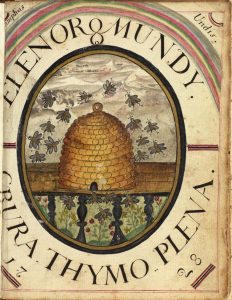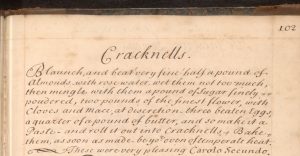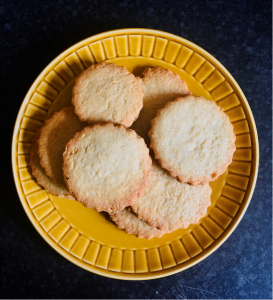September 3, 2020, by Kathryn Steenson
Elenor Mundy’s Cookery Book: Cracknells
This is a guest post by Library Assistant Safiya Williams.
Like many during these strange and uncertain times I have found comfort in food, faced with shelves empty of my everyday food staples – pasta, rice, yeast – I found myself flipping through cookbooks and notebooks trying to make do with what I have. I searched for answers to the questions that so many of us faced, ‘How do I make bread without yeast’, ‘cakes without eggs’ and so on; whilst also turning to my social media community of cooks, chefs, family and similarly struggling food friends rallying together by sharing recipes and techniques. Each time I watched or read, I made a note of my creations, successes or failures, and in doing so I have created a magpie-like, handwritten cook book of my own.
Whilst noting down my recipes, I often thought of one of my favourite items in the collection at MSC – Elenor Mundy’s Cookery Book, a manuscript recipe book containing household recipes created by Elenor Mundy in 1728.
The only information given about the recipe book’s owner, is the inscription on the decorated front cover, which includes the year (1728) and the Latin tag ‘Crura Thymo Plena’ – a quote from Virgil’s Georgics (Book 4, Line 181) (Perseus Digital Library, 2007)
…Grandaevis oppida curae
et munire favos et daedala fingere tecta.
At fessae multa referunt se nocte minores,
crura thymo plenae; pascuntur et arbuta passim……The old have charge
To keep the town, and build the walled combs,
And mould the cunning chambers; but the youth,
Their tired legs packed with thyme, come labouring home…
The later pages show some contributions from other family members in later years, (including the names Leche, Newdigate and Willoughby). This perfectly illustrates the depth of meaning in the line inscribed on the cover – the older generation ‘keep the town’ and build the foundation in creating the recipe book, whilst ‘the youth’ return with more knowledge and development ‘legs packed with thyme’.
In the spirit of sharing and adapting for my own tastes in lockdown, I wanted to try one of the recipes for myself. After flicking through several elaborate ingredients lists, I landed on a recipe for ‘Cracknells’, which seemed straightforward and easy to adapt if needed. I also liked this recipe as it includes a single sentence review that they are ‘very pleasing’.
Handwritten recipe for Cracknells from Elenor Mundy’s cookery book, c.1728 (Ref: MS 86)
Cracknel or Cracknells: A general term for a crunchy biscuit, especially if thin and of a curved shape. The term is also used for a variety of crispy sugar-bound crunchy mixtures. (Foods of England, 2018)
I made a few changes to the recipe based on the contents of my cupboards, my own preferences (I don’t like cloves) and that I don’t really need as many biscuits as the volumes for the original recipe would suggest.
Cracknells (original)
0.5lbs ≈ 250g blanched almonds
1tsp rose water
1lbs ≈ 450g sugar (finely powdered)
2lbs ≈ 900g flour
Cloves and mace
3 eggs
0.25lbs ≈ 110g butter
Cracknells (adapted and scaled down)
60g ground almonds
1ml rose water
110g caster sugar (blended to fine powder)
225g plain flour
1tsp nutmeg
1 egg
50g butter
Before baking I refrigerated the dough as it was quite greasy and difficult to work with, something that can be resolved by reducing the butter in future batches. I baked the biscuits in an oven preheated to 180 degrees, for about 12 minutes (or until golden brown. They also benefited from being completely cooled before eating to get the best crunch. The scaled down version made about 48 medium sized biscuits.
These baked into a perfectly buttery, crunchy biscuit and a fantastic base to adapt with other flavours (e.g removing the nutmeg and adding dried lavender or reducing the plain flour slightly to add cocoa powder).
The University of Nottingham collects archival material relating to the East Midlands. This recipe book is one of several held in the collections held at Manuscripts & Special Collections at Kings Meadow Campus. The Reading Room at Kings Meadow Campus is currently closed due to Coronavirus, but we are running a limited enquiry and reprographics service. For more information, see www.nottingham.ac.uk/mss or email mss-library@nottingham.ac.uk
No comments yet, fill out a comment to be the first




Leave a Reply